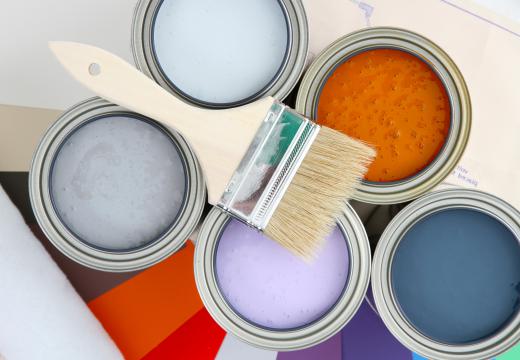The ingredients used to make paint vary widely, depending on location, environmental regulations, and available resources. Typically, paint raw materials can be classified into specific categories. All paints, from simple homemade paint to interior or exterior household paint and automotive finishes, require a pigment, a resin, a solvent, and certain additives to enhance the properties of various ingredients. Which raw materials are used for each of these components varies with availability, cost effectiveness, and environmental impact.
To understand paint raw materials, it is first necessary to understand each components' purpose. Pigments or dyes provide the color for paint. Resins are those substances used to bind the paint to a particular surface after drying. Solvents prevent the paint from drying or separating prior to its application, keeping the resin and pigments from losing the ability to form a dried, colored film on a particular medium. Additives vary, depending on the specific application for which the paint is mixed, but enhance things such as how easily paint spreads and how well paint bonds to specific surfaces, or they may affect the drying time of the paint.

Early paint raw materials, such as those used in ancient times to create cave drawings and Egyptian hieroglyphs, were naturally occurring substances. Plants, insects, and animals, as well as powdered rocks, minerals, and other matter, provided much of the raw pigments and resins. Water was the most common solvent. Some additives, such as dirt, flour, or other organic materials, were added to thicken paint or provide a texture once paint dried.
Organic paints, such a milk paint, follow many of the same principles as early chemists with regard to paint raw materials. Cow or goat milk mixed with various minerals or iron oxides provides the resin base and a solvent. Dried plants, various insects, and even dirt provide the necessary pigments. Marble, chalk, clay, and flour can also serve as resins, fillers, or additives that add both texture and starch to help bind paint to surfaces.
Commercially produced paints typically use chemicals and heavy metals as paint raw materials. Oil or petroleum-based chemicals are used for pigments, solvents, resins, and additives. Compounds such as calcium carbonate and magnesium silicate produce color variations when combined with primary compounds such as titanium dioxide for white paint. Urethane and urethane derivatives are commonly used in enamel paints as both a resin and a solvent. Water and acrylic emulsion compounds are commonly used in latex paint as solvent and resin raw materials.
Many paint raw materials used in organic recipes are also used in commercial paint-making. For example, iron oxide is used in both organic paint and commercial paint, often to produce red color tones. Chalk, limestone, and other minerals are commonly used in both types of paint, although commercial paint production usually requires additional processing of some minerals and other raw materials. Due to large batch production, raw materials used must meet certain standards to ensure consistency and purity for the final paint product.
